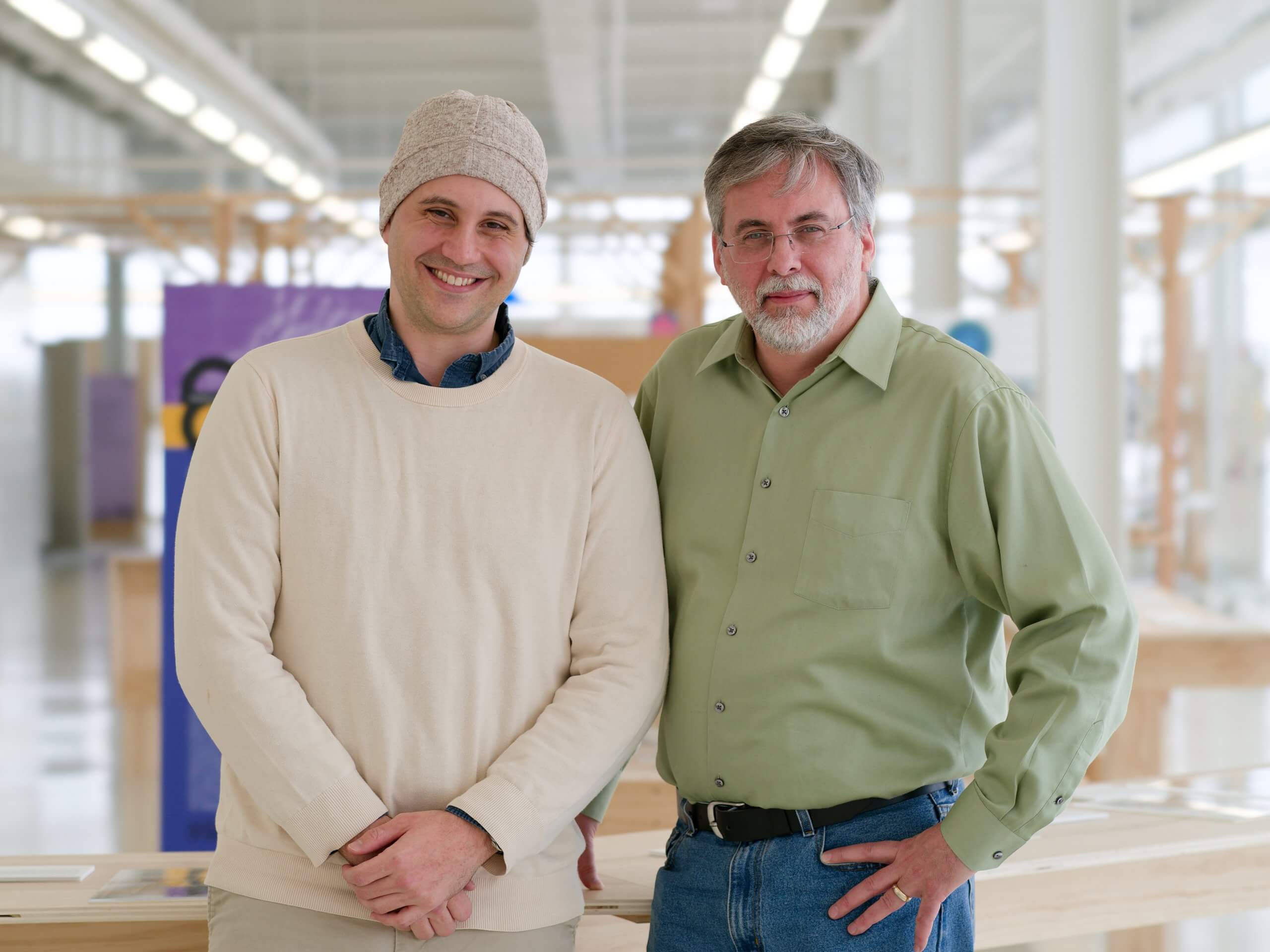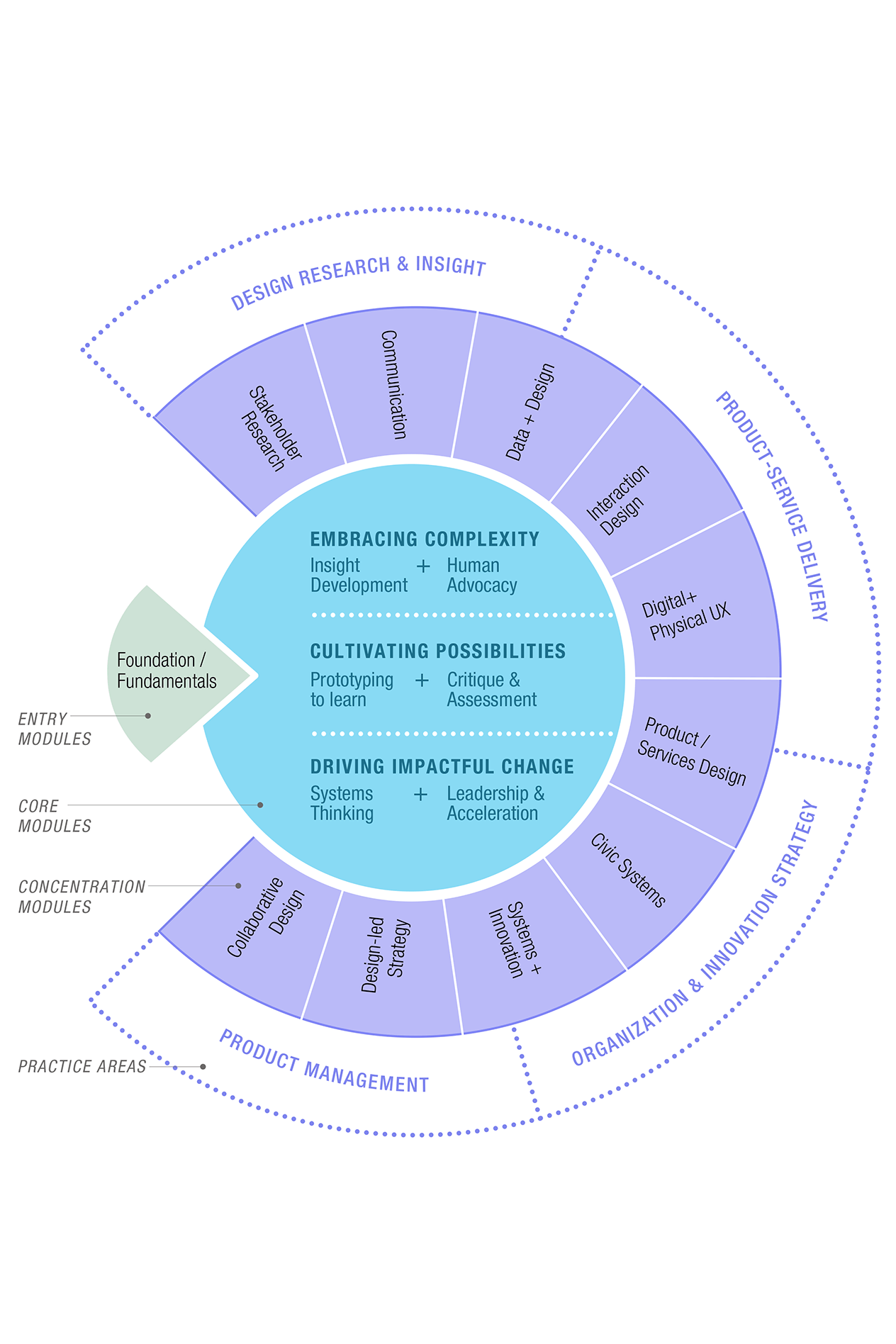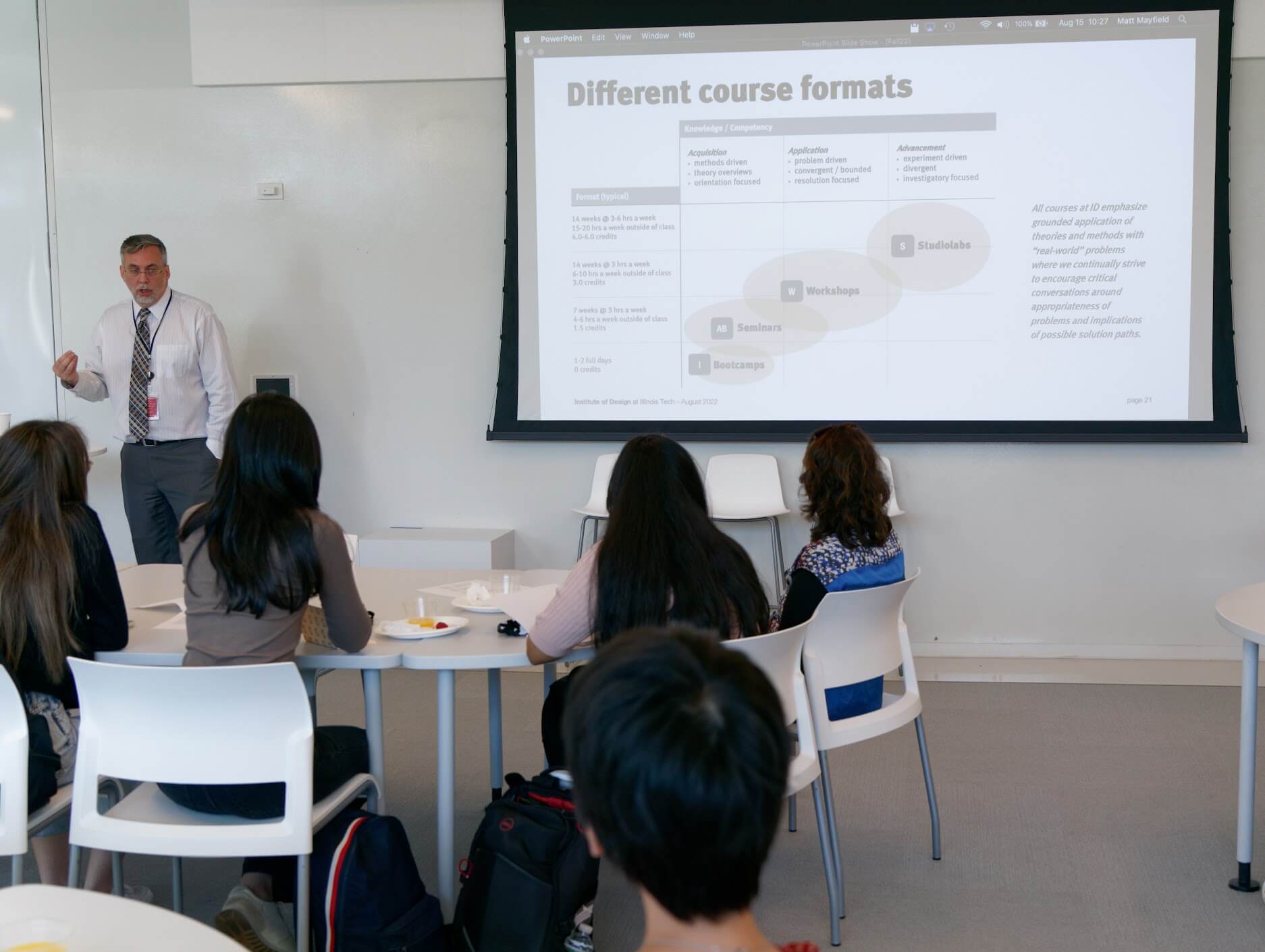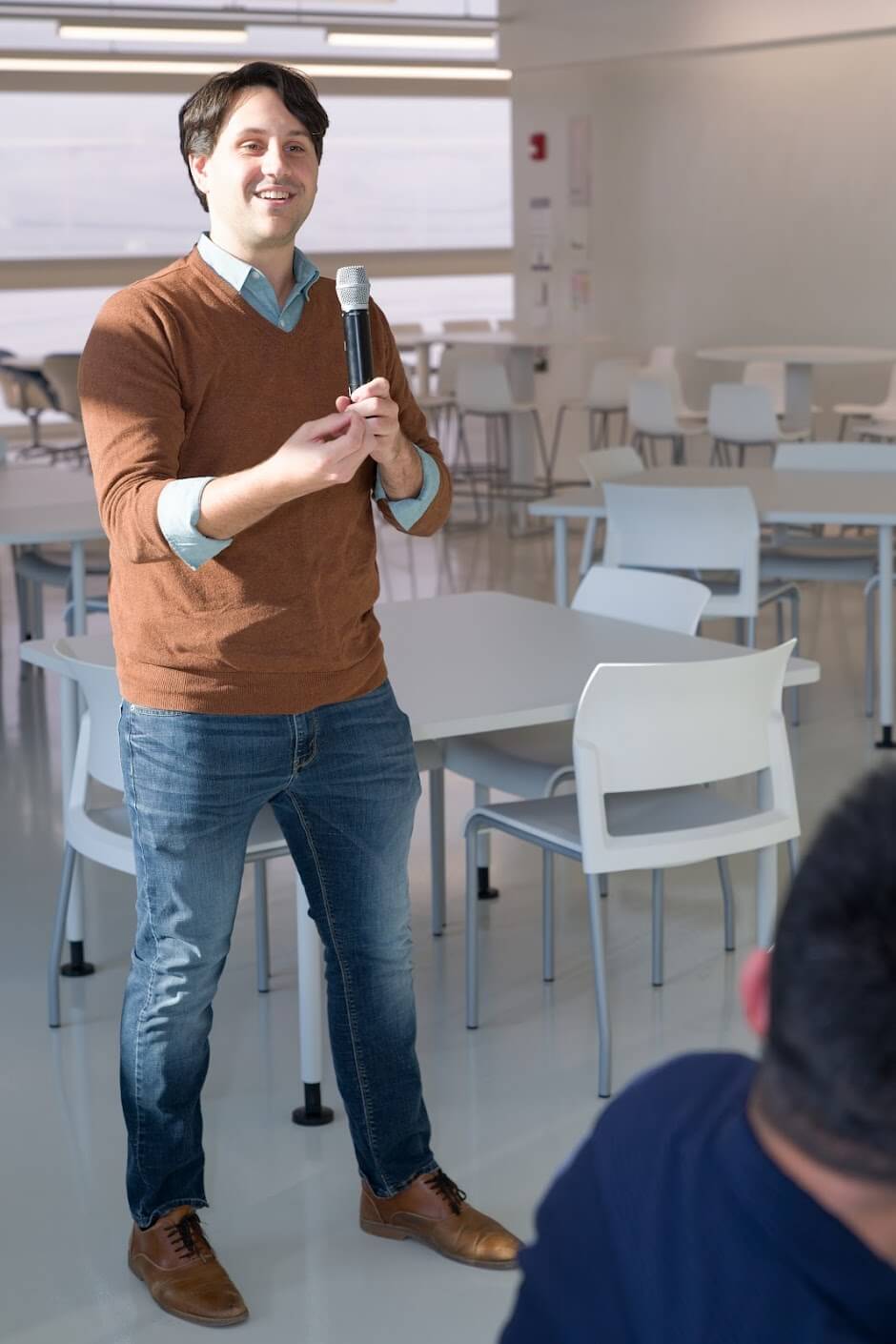How Do You Teach Design for Tomorrow?
By Jarrett Fuller
February 22, 2023

The design fields are in the midst of rapid change — technological, cultural, political, and societal. Designers consistently find themselves in new domains and working with new tools. The old frameworks for design education — that presume certain processes, tools, and outcomes — are no longer sufficient. How do you teach design today for a future that is uncertain? What does it mean to teach design today? What do today’s design students need to know to practice design? What is the value of design education and its role in the industry?
In an attempt to answer these questions, I speak with Matt Mayfield and Zach Pino. Matt is the Associate Dean of Academics and Administration at ID, a position he’s held since 2017 after joining ID in 2001. He leads all curriculum development with the full-time faculty and has developed courses at ID in product and portfolio planning, contextual research design, and computer-aided design processes.
Zach is an Assistant Professor of Design and serves as ID’s lead digital tools instructor and digital product facilitator. His work centers around how contemporary objects can embed data in their fabrication, functionality, and form.

MDes Curriculum Wheel
JF— Matt, you’re the Associate Dean of Academics and Administration and oversee all the curriculum at ID. How do you think about the curriculum? Can you talk about the process of putting a curriculum together in an institution like ID?
MM— One of the things that’s important to say is we didn’t start from scratch. We came into a school that was very established, doing very well and had found its way through the changes of design over the years. So part of the challenge was how do we continue that progress? How do we continue its strength while also being open to changes? In moving into this role, one of the things that I really wanted to stay focused on was preserving that flexibility and that ability to continually refresh without having to rethink the entire thing.
That’s where I think curriculum and schools can sometimes get in trouble. They’re like, “Okay, we feel a little out of step, let’s rethink the whole thing.” Then it takes two years and lots of debate yet students are going through and they’re learning. I’m happy that we’ve got such a gracious faculty that’s willing to go along with the idea that we do have to adjust and integrate new ideas as they come in.
On the other side, we think about the student journey and where they’re coming from. As a graduate-only school, we have a luxury — which we protect a lot — that most of these students have professional experience. They’ve had some time to mature so we’re not going to worry as much about basics, about whether design is something that they should consider as a focus in their education, or whether they think they can build a career out of it. They’ve worked through that already and we can come in and say “Yes, we all agree. Design is a really interesting field. There’s lots to learn here and lots to use. Now let’s take that step.”
I have been lucky to start with those very strong points of flexibility and a fairly well-developed student body so that we can step into some bigger issues. We still have challenges, of course. Like anybody else, it’s hard to change, but that’s where we’re starting from.
JF— Can you talk a little bit more about the connections between the history and the present day? What are ideas from the school’s history that you think are still important and relevant in the curriculum today? Then where you are innovating? Where are you trying new things that wouldn’t have been there ten or twenty years ago?

MM— Some of the throughlines in the curriculum have been the importance of experimentation. This goes all the way back to the Bauhaus idea of the capabilities of technology and industry and how, as designers, we can take advantage of these capabilities to build the things we want to build, or at least articulate the futures we see that are more desirable than where we are now. That’s always been there and I think that continues.
Back in the early days, it was much more about physical production and how to make things more reliable and more ergonomic and things like that. I remember as a student, we would be looking at production methods and ways to incorporate all sorts of different really exotic materials like plastic and rubber and all that stuff. We’re asking similar questions now but we’re talking about digital capabilities of managing massive amounts of data and interpreting that for an individual, specific context.
I think the other part is that we broke free from a strong arts background a while ago. It’s never been super strong in our program because we’ve been more pragmatic, we’re more functional in our approach to design for better and for worse. It served us well when we moved into things like design thinking and our relationship with business where we could say design can help make whatever those products and services are better. We still have to define what better is, but that’s what designers are really good at. What I’m getting to is that we weren’t beholden to notions of artistic expression and that helped us to define other ways of contributing and authoring our work.

JF— Zach, you have a background in computer science. You’re teaching a lot of digital tools and emerging technologies and I want to know how you think about that. I’ve seen this happen two ways. First, where designers learn about new technologies purely conceptually, basically that these things exist and you should know about, say, artificial intelligence for example. Or you should look know about big data. And then on the other side, it’s approached really technically where it’s like you need to learn how to use this software or you need to code in this language. But it seems like there must be some sort of balance between those two. How you approach that. How you think about introducing new technologies into a curriculum.
ZP— That’s a fantastic question. I think fundamentally when I came into ID seven years ago, I came into a school that, as Matt described, was very much, from my naive point of view, tied much more to the business side than the personal expression side. So a lot of students at that time saw their opportunities as a designer tied to opportunities in consulting, opportunities in entrepreneurship, opportunities in joining in-house design teams that were fairly well-established but over the last seven years at ID, we’ve seen this kind of seismic shift in what our students’ goals are as designers.
So when I joined ID, students were very interested in picking up very hard technical skills because they knew that in some ways they would be going into the world to deploy design, whether that meant entrepreneurially building a digital product or needing to know enough about technology to communicate with an engineering team within their organization. So in those early years, Matt was really open and flexible to us introducing courses in Python and JavaScript, those kinds of very hard technical skills.
In more recent years, however, we’ve seen students with much, much less — almost zero — interest in that kind of engagement with technology, which we suspect is very much tied to changing social dynamics, relationships with technology, and presumptions and perceptions of technology. Instead, we see our students wanting to be working at a higher level and engaging engineering processes and engineering teams with critical oversight. Our curriculum has needed to shift to accommodate that new goal that our students might have in their professional careers after graduate school which means we are teaching not, “this is how to write this kind of function in Python” — though we certainly still do that — but now we also have courses such as surveys in emergent technology, studio courses in data visualization where we’re not teaching students how to necessarily write all of the code for making interactive data visualizations but exposing students to data visualization tools and disciplinary norms, then allowing them to explore what would it mean to hand draw a data visualization. As Matt hinted at, returning almost to the personal expression and personal agency associated with a traditional art and design program.
JF— I think one of the challenges in design education today — and this comes up in so many conversations that I have with educators — is that the field of design is so big. The areas into which students can go is infinite. You could go into data visualization, you could go into systems design, you could go into interface design. So there’s this tension between surveying all the opportunities and presenting the range of work while also having to go deep on some of those because it can’t just be this cursory look.
How much of this is student-driven? Are students sort of coming into the class saying, we’re interested in these things, and then you’re tailoring these surveys to that as opposed where you say, “Here are some things that I think are interesting, here are some emerging practices, emerging technologies, and I’m going to kind of show these to you.”
ZP— I’m confident that in our courses, the model student needs exposure to contemporary technologies more than they need any degree of mastery over those technologies. Trends in technological development today have facilitated that new orientation for our student body. We’ve seen this kind of incredible convergence of what was several years ago, as you described, a very wide diverse but disparate set of technical competencies. So data visualization is going to be different than interaction design, which is going to be different from CAD, 3D modeling for fabrication
In the last several years, certainly, in the COVID and post-COVID time, there’s been this massive alignment and convergence in data-oriented practice, where every discipline of design and every technical vertical that a student might be interested in pursuing is going to be centered deeply in engagement with data and engagement with computational intelligence and computational creativity. And because of that alignment, it becomes a lot easier for us to teach that. Because we can go deep into what data is — these are the dimensions of data quality, these are the metrics by which we would evaluate to what degree a data set is valuable in design insight making — we don’t need to necessarily cover the waterfront.
MM— I believe designers can be more inspired when they have a little bit more than just awareness of something. They have to play with it. They have to say, “Oh, wait, this can do this. What if I do this?” That’s where we get that fun creativity.
For me, I want to get our students to the point where they can play with technology. We’re not going to ever say, “Okay, you are a certified engineer putting out commercial-grade solutions,” but we do want them to be able to engage engineers, or whoever is involved with the development at these different levels, at a higher level: Are we doing this ethically? Are we being equitable? Where are our blind spots with how we are using this technology or the ways we see it progressing? But also at a lower level where it’s also “Hey, did we ever think about trying this? Would that be valuable?”
That’s the key question for all of our students: Where is the value? I’m purposefully making that a very ambiguous term because that’s the discussion. What do we mean by value? Where is it? How can we get to it? Does everyone agree on that value? So being able to poke around in the technology enough to get a feel for it to understand the power, because a lot of it is abstract when you say, “Machine learning takes in troves and troves of information.” Do you really know what that means? You could say it, but do you really feel it? That middle ground in exploring is where I get most excited. So we do try to respond to students where they’re at and where they’re going, but also to challenge. Why are we learning this? Where is this going to help us in our practice as designers?
JF— Speaking of value, I want to turn that back on the education experience. I think graduate design education is in an interesting spot where it can also do all sorts of things. There is some sense of job preparation, of understanding the field and giving you skills to go work in the field. There’s some sense of experimentation, that grad school is a laboratory to try things, to be critical, to be provocative, to challenge things. There’s some sense of graduate school being a chance to redefine the field, to redefine design, to challenge industry, to push industry forward. It’s a little of all of those plus more. How do you think about the role of graduate design education? What is the value that students get out of those two years?
MM— It’s a great question. For our school, and the students that we attract and the students that are successful coming through our program, they’re not coming to us saying, “I want to get a job in UX and I’m going to come here to get trained to do that.” We think that’s a bit of a flag because yes, it’s possible to do that, but that’s really not what the full experience can be. That full experience is a time to reflect. That’s why we’re so excited when we have somebody that has been practicing design for a little while and saying, “Hey, you know what? I think I want to learn more about my field and my practice. I want to explore a little bit, broaden my horizons.” We love that. I think those students do the best in our program, and it’s that reflective nature.
For me, that’s where the value is. If we want to get it down to the crass exchange here, depending on the program, they are choosing to spend a couple of years to step back from their practice, to not be stuck in the constraints of a job-oriented right workload, and to give themselves a little bit of freedom to explore and think.
For some students,they just stumbled into their design practice. They learned on their own. They never really had a chance to examine it in a more formal setting. So we can support that — not just with the faculty, but with other students. I think that’s where our program is strongest: within the cohort, the community of students that are able to bring different perspectives and different experiences.
These students want to be masters in design. How do we get them to be masters? What does that mean? The ability to have a lot of perspectives and be able to ask great, important questions that open up conversations, that move things forward, that bring insight to the debate, that are able to inspire others to see maybe the opportunities in a different way.
To me, if a student walks out of here doing that, they’ve gotten what they came for. They are well-positioned to influence wherever they land, and whoever they work with because they won’t be doing it alone. That’s where I kind of anchor the value of at least our program.
ZP— What’s so hard about any sort of engagement with a graduate curriculum is that you are, in the case of many of our students, coming into a new discipline or some kind of minor to extreme reorientation within your discipline. Everyone in a graduate program is going to be talking almost exclusively about how quickly the field is changing. And that is especially true of design.
Design was very well-defined and established in the nineties and then aughts. Ever since, it has really been challenged in almost every flank, whether that’s the implications of being a creator in a world with significant sustainability challenges or being a responsible researcher, but also being tied to certain kinds of ill-defined business metrics and timelines.
So our students are coming in and they’re seeking clarity. They’re seeking a lane to place themselves in and all we can do is tell them there are no lanes right now, or the lanes are yet to be established. The students who are most effective here at ID, from my point of view, are those that are willing to embrace that ambiguity and recognize that their time with us is to help establish those lanes for the next generation of designers and design students.
MM— I do think that’s where design is most exciting. It is in the new intersections, in the new applications, in the new types of jobs. When I graduated from my undergraduate in design, we essentially focused on design thinking, but no one recognized it that way. No companies were hiring design thinkers. It wasn’t there. But there was the confidence that I could add value, it just took time to figure out how to define that in the terms of the day. It is challenging in that it’s a field in flux, but the most exciting part is that flux gives you opportunity.
JF— I want to go back to an idea that’s come up again and again about this push and pull of artistic expression. So much early design theory and history was really about separating design from art. Certainly, on the surface level, those can feel at odds with each other: You have human-centered methodologies, developing personas and user experience, and all of these things on one side, and then the designer’s point of view, of expression, of authorship on the other. How do you blend these? How do you show that both of these things can happen at the same time?
MM— Most of the classes I teach are business-oriented: how to plan product lines and how to think about what’s next with more sophisticated products. That being said, I talk a lot about how the work we do in design — and thinking about what’s possible — has to be grounded in research and information. We want to make good decisions. There is a point in every project, in everything that you as a designer, where you are interpreting. You have an authorship role in how this work is being handled, how you adjust, and how you conform to your constraints. That’s you making choices and I think we should embrace that.
It may not be the free-form expression of art, but there is an authorship. There is a decision to say, “This is the way I’m looking at this problem. This is the way that I chose to shape it, interpret what we’re seeing with a team or without a team.” You should embrace that. You do have a place in this. You do have a voice. We obviously have biases and we have all sorts of blind spots, so you have to be aware of that. So pay attention to it, but don’t ever suppress your voice. You are not a machine to make objective work. Design is still very much, I believe, a subjective field. It’s an interpretation of what we think should be or could be or ought to be. Those are the things that designers should be thinking about and you can’t remove yourself from that conversation.
ZP— I, like many of our students, entered design not from a straight path. The field that I entered circa the mid-2010s was really a field that had over-expressed and overexerted itself so much into adjacent disciplines, whether that was the social sciences or engineering, that it had, in some ways, lost a sense of itself and its own core value and competencies.
So this kind of retreat that many of the design disciplines have gone through in the last ten years or so really reflects this recognition that design had not only overexerted itself, but it had become reliant on a very kind of convoluted self-justification: “I’m going to go out into the world and I’m going to say this is what the world is asking for. That’s the problem. I’m calling that the problem and now I’m going to solve it, and here’s my answer to that problem.” It creates this weird circular logic that’s still deeply embedded in a lot of traditional design practices and business-oriented design practices where you lose sight of the fact that you are a creator. You are identifying this particular set of issues to address with your creative outputs.
That, for many of our students, is incredibly refreshing because they’re wanting to bring this value-driven or ethics-driven motivation. They’re working on behalf of inclusion, equity, and sustainability. They’re wanting the work to reflect their vision and not mask that in what the company is asking of them in the brief, or some set of personas that they’ve developed and artificial problems they’ve identified.
JF— What about design is exciting you right now?
MM— There’s an optimism that’s coming in. Designers can’t stop at outrage or critical thinking. We have to say “What do we do about that? Where do we go?” I feel very encouraged that these students are going to go out and make fantastic impacts in the world because they can bring that optimism and those values into their work.
ZP— I am extraordinarily driven at this particular moment in design as a discipline’s trajectory by the fact that today’s design does not need to be resolved fully or even fully understood by the designer when it is introduced into the world. I know that that sounds really scary and that I might be promulgating a certain kind of sloppiness with design practice, but with so many data-oriented tools and computationally intelligent tools today, we have this remarkable capability to design and experience 80%, 50%, 20%, and then let context and dynamics and preferences and dimensions of the human engaging our designs fill in that remaining space. As I say, that is often scary at the moment, and we’re seeing the limitations and weaknesses and over-exuberance by many computational designers but this opportunity to create not singular, fully understood designs, but rather incredibly intricate, complicated, flexible, dynamic multiples of our experience, that as a designer I might not ever fully comprehend, is really just a tremendous moment in design.